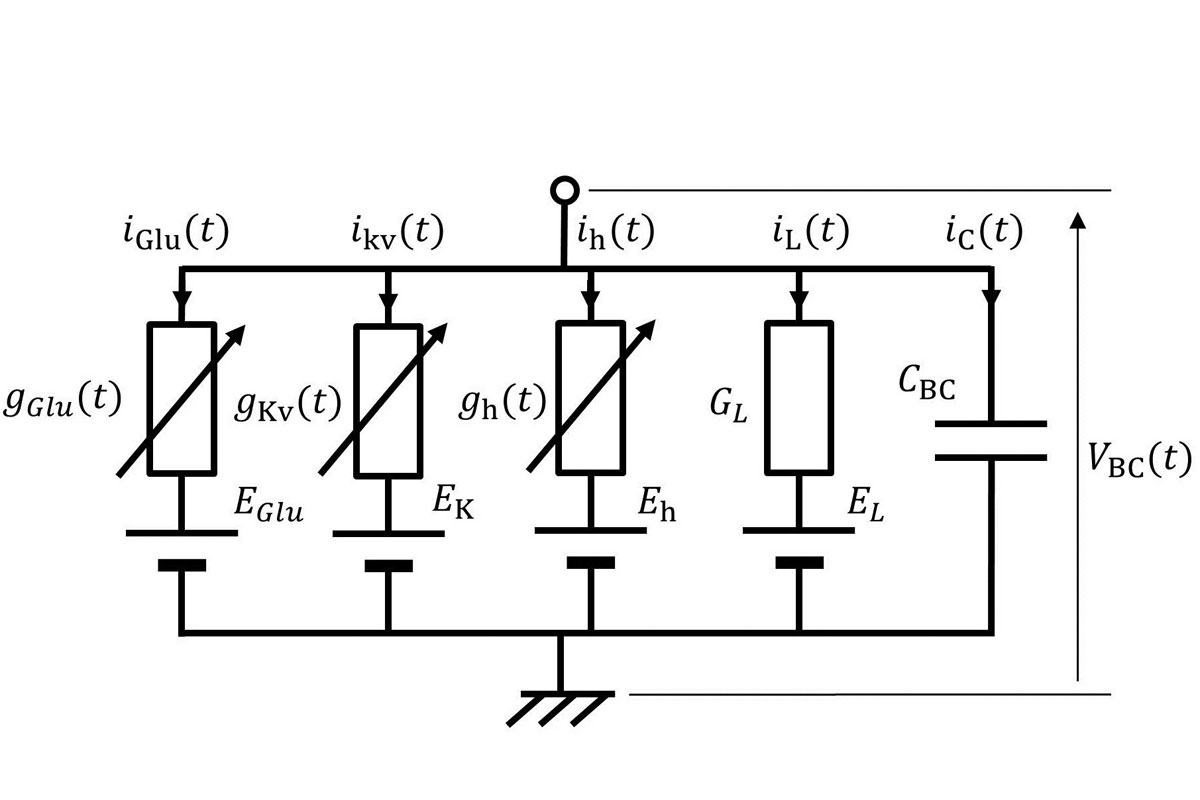Keywords
Abstract
The retinal cone bipolar cells are interneurons which receive inputs from cone photoreceptors and send outputs to retinal ganglion cells. Several subtypes of bipolar cells have been identified by morphology and electrophysiology in the mammalian retina, which convey distinct visual information to higher order neurons in parallel. The neural circuit in the retina not only converts light information to neural . information, but also performs visual information preprocessing that has not yet been fully understood. Recently, it has been revealed that the neural circuits in retinas of higher vertebrates, such as mammals and primates, have various biophysical properties arising from being composed of ionic channels, ionic pumps, and neurotransmitter receptors. Analysis using a mathematical model based on their ionic mechanisms is essential to understand the visual information processing in the retinal neural circuit of the higher vertebrates.
The cones and the bipolar cells respond to continuous variation of light with a graded potential, in an analog manner. Especially, glutamate is continuously released from a cone synapse in the dark and is decreased by hyperpolarization of the cone that receives the light stimulus. The alpha-amino-3-hydroxy-5-methyl-4-isoxazolepropionic acid (AMPA) and kainate type ionotropic glutamate receptors (iGluRs) of the OFF type bipolar cells (OFF-BCs) exhibit partial or nearly complete desensitization in the sustained presence of glutamate. In the dark, glutamate concentration in the synaptic cleft of the cone pedicle rises to 0.1–0.5 mM.5,6 The baseline glutamate concentration depends on a sustained hyperpolarization of the cone by light. Thus, for understanding the working of the OFF-BCs, it is important to elucidate the mechanisms of synaptic transmission from cones to OFF-BCs via iGluRs, which undergo desensitization in the various background light conditions. Furthermore, there are various kinds of ionic channels in OFF-BCs that mediate membrane potential responses. It is considered that information transmitted from cones to OFF-BCs is modulated by the intrinsic ionic currents. We analyzed how ionic currents of OFF-BCs contribute to the transmission of light responses by developing a mathematical model.
References
Euler T, Haverkamp S, Schubert T, Baden T. Retinal bipolar cells: elementary building block of vision. Nat Rev Neurosci. 2014;15:507-519.
DeVries SH. Bipolar cells use kainate and AMPA receptors to filter visual information into separate channel. Neuron. 2000;28:847-856.
Lindstrom SH, Ryan DG, Shi J, DeVries SH. Kainate receptor subunit diversity underlying response diversity in retinal Off bipolar cells. J Physiol. 2014;592:1457-1477.
Ichinose T, Hellmer CB. Differential signalling and glutamate receptor compositions in the Off bipolar cell types in the mouse retina. J Physiol. 2016;596:883-894.
DeVries SH, Li W, Sazik S. Parallel processing in two transmitter microenvironments at the cone photoreceptor synapse. Neuron. 2006;50:735-748.
Nielson TA, DiGregorio DA, Silver RA. Modulation of glutamate mobility reveals the mechanism underlying slow-rising AMPAR EPSCs and the diffusion coefficient in the synaptic cleft. Neuron. 2004;42:757-771.
Pan Z, Hu H. Voltage-dependent Na+ current in mammalian retinal cone bipolar cells. J Neurophysiol. 2000;84:2564-2571.
Hu H, Pan Z. Differential expression of K+ currents in mammalian retinal bipolar cells. Vis Neurosci. 2002;19:163-173.
Ma Y, Cui J, Hu H, Pan Z. Mammalian retinal bipolar cells express inwardly rectifying K+ currents (Ikir) with a different distribution than that of Ih. J Neurophysiol. 2003;90:3479-3489.
Usui S, Ishihara A, Kamiyama Y. Ionic current model of bipolar cells in the lower vertebrate retina. Vis Neurosci.1996;36:4069-4076.
Ishihara A. Simulation analysis of temporal coding by ionotropic glutamate receptors of retinal Off-type bipolar cells. Sensor and Materials 2018;30:299-313.
van Hateren JH, Snippe HP. Simulating human cones from mid-mesopic up to high-photopic luminances. J Vis. 2007;7:1-11.
Ishihara A, Kamiyama Y, Usui S. Analysis of light response of the retinal bipolar cells based on ionic current model. Computational Neuroscience: Trend in Research. New York: Plenum Press, 1998; 203-209.
Ishihara A. Simulation study of information transmission in OFF cone bipolar cell pathway. ARVO Annual Meeting. Honolulu, HW, 2018; Abstract 1873-C0177.
Ma Y, Cui J, Pan Z. Heterogeneous expression of voltage-dependent Na+ and K+ channel in mammalian retinal bipolar cells. Vis Neurosci. 2005;22:119-133.
Ichinose T, Shields CR, Lukasiewicz PD., Sodium channels in transient retinal bipolar cells enhance visual responses in ganglion cells. J Neurosci. 2005;25:1856-1865.
